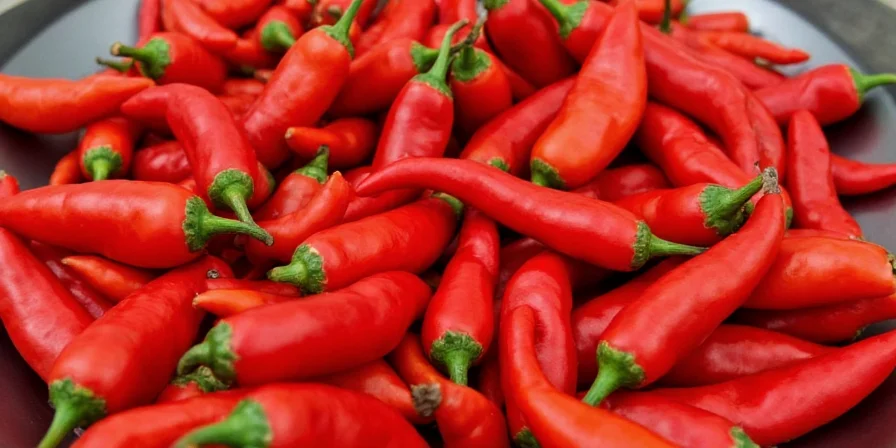If you've ever explored Mexican cuisine or dried chilies, you've likely encountered guajillo peppers. But here's the critical question: how hot are guajillo peppers? Are they a mild flavor enhancer or a heat powerhouse? Let's uncover what makes this essential chili unique.
This definitive guide explores their precise Scoville rating, nuanced flavor profile, versatile culinary applications, and professional preparation techniques. Whether you're a novice cook or spice connoisseur, you'll gain actionable knowledge for maximizing guajillo's potential in your kitchen.
Table of Contents
- Guajillo Peppers Heat Level
- What Do Guajillo Peppers Taste Like?
- Common Culinary Uses
- How to Work With Guajillo Peppers
- Guajillo vs. Other Popular Chilies
- Innovative Applications Beyond Tradition
- Fun Facts About Guajillo Peppers
- Frequently Asked Questions
- Final Insights
🔥 Guajillo Peppers Heat Level Decoded
Guajillo peppers register between 2,500 and 5,000 Scoville Heat Units (SHU). Contextual comparison:
- Jalapeño peppers = 2,500 – 8,000 SHU
- Serrano peppers = 10,000 – 23,000 SHU
- Guajillo peppers = 2,500 – 5,000 SHU
They sit at the milder end of Mexican chilies, prioritizing complex flavor over intense heat. This makes them ideal for dishes requiring depth without overwhelming spice.
💡 Pro Tip:
Heat intensity varies based on harvest maturity and preparation. Removing seeds and veins reduces spiciness by 30-50%, while leaving them intact maximizes heat extraction during cooking.
🌶️ Guajillo Flavor Profile Analysis
Guajillos deliver a sophisticated flavor spectrum beyond simple heat:
- Tangy fruitiness with subtle berry undertones
- Earthy base notes reminiscent of sun-dried tomatoes
- Light smokiness from natural sun-drying process
- Leathery texture that thickens sauces beautifully
This multidimensional profile explains their dominance in complex sauces like mole rojo. Toasting before rehydration unlocks deeper caramelized notes.
🍴 Essential Culinary Applications
Guajillos anchor foundational Mexican dishes while offering modern versatility:
- Signature Sauces: Primary ingredient in authentic red enchilada sauce, providing body and balanced flavor without excessive heat.
- Mole Complexity: Blended with mulato and ancho chilies to create layered depth in Oaxacan mole.
- Meat Enhancements: Ground into rubs for carnitas or adobo marinades, where their acidity tenderizes proteins.
- Vibrant Salsas: Soaked and blended with tomatoes for restaurant-style salsa roja.
🧄 Professional Preparation Method
Maximize flavor through this chef-recommended process:
- Surface Cleaning: Rinse under warm water to eliminate dust while preserving essential oils.
- Controlled Toasting: Heat in dry skillet 20-30 seconds per side until fragrant but not blistered.
- Optimal Rehydration: Soak in 175°F (80°C) water for 15 minutes—exceeding 20 minutes causes bitterness.
- Precision Blending: Combine with garlic, cumin, and ¼ cup soaking liquid for smooth emulsion.
🔍 Comparative Chili Analysis
How guajillos stand against comparable chilies:
| Chili Pepper | Scoville Heat Units (SHU) | Flavor Profile | Best Culinary Application |
|---|---|---|---|
| Guajillo | 2,500 – 5,000 | Fruity, tangy, berry notes | Enchilada sauce, mole, marinades |
| Ancho | 1,000 – 2,000 | Sweet, raisiny, earthy | Mole sauces, soups |
| Pasilla | 2,500 – 4,000 | Grassy, dark fruit, licorice | Stews, sauces, tamales |
| Chipotle | 2,500 – 8,000 | Smoky, sweet, peppery | Adobo, grilled meats |
| Cascabel | 1,000 – 3,000 | Nutty, earthy, toasted | Salsas, soups, stews |
✨ Beyond Tradition: Modern Applications
Innovative chefs are leveraging guajillos' unique properties in unexpected ways:
- Barbecue Innovation: Blended into dry rubs for smoked brisket, where berry notes complement caramelized crust.
- Chocolate Synergy: Paired with 70% dark chocolate in mole-inspired desserts for balanced heat-sweet contrast.
- Zero-Waste Dyeing: Simmered to create vibrant natural fabric dyes (non-toxic and biodegradable).
- Cocktail Complexity: Infused in tequila for nuanced spicy notes without overpowering agave flavors.
These applications demonstrate guajillo's versatility while honoring its culinary heritage.
🤔 Guajillo Pepper Insights
- They rank as Mexico's second most consumed dried chili, surpassed only by ancho peppers.
- The name derives from Spanish "gajo" (segment), referencing their distinctive ribbed structure.
- Natural sun-drying preserves volatile compounds that machine-drying destroys, enhancing flavor complexity.
- Whole dried guajillos maintain peak flavor for 12-18 months when stored in airtight containers.
❓ Frequently Asked Questions
How do guajillo peppers compare to jalapeños in heat?
Guajillos (2,500-5,000 SHU) are generally milder than fresh jalapeños (2,500-8,000 SHU). While jalapeños can reach higher maximum heat, guajillos provide more consistent mild-to-medium warmth ideal for layered sauces.
Can I substitute ancho peppers for guajillos?
Yes, but expect flavor differences. Anchos (1,000-2,000 SHU) are sweeter and less tangy. Use 1:1 ratio but add ¼ teaspoon vinegar per pepper to mimic guajillo's acidity. For heat matching, combine anchos with a pinch of cayenne.
Do I need to remove guajillo seeds before cooking?
For authentic flavor balance, retain seeds. They contain 70% of the capsaicin but also crucial flavor compounds. Remove only if serving heat-sensitive audiences. Professional chefs typically keep seeds for depth, adjusting heat with liquid ratios instead.
How can I tell if dried guajillos are still fresh?
Fresh guajillos should snap crisply when bent (not bend limply). They'll display deep reddish-brown color (not faded) and emit a fruity aroma when toasted. Avoid any with white mold spots or musty smell, indicating moisture damage.
What's the best storage method for dried guajillos?
Store in vacuum-sealed containers with oxygen absorbers in complete darkness. Refrigeration extends freshness to 24 months. Avoid pantries near stoves—heat accelerates flavor degradation. Never store in clear containers exposed to light.
🎯 Final Insights: Maximizing Guajillo Potential
Guajillo peppers deliver mild-to-medium heat (2,500-5,000 SHU) with exceptional flavor complexity that elevates dishes without overwhelming spice. Their tangy-fruit profile makes them indispensable for authentic Mexican sauces while inspiring modern fusion applications.
Mastering their preparation—particularly precise toasting and controlled rehydration—unlocks their full potential. Whether crafting traditional mole or experimenting with innovative infusions, guajillos offer unmatched versatility for creating balanced, nuanced dishes that satisfy diverse palates.
💬 Share Your Guajillo Innovations
How have you creatively used guajillo peppers? Contribute your unique recipes and techniques to help fellow culinary explorers!











 浙公网安备
33010002000092号
浙公网安备
33010002000092号 浙B2-20120091-4
浙B2-20120091-4